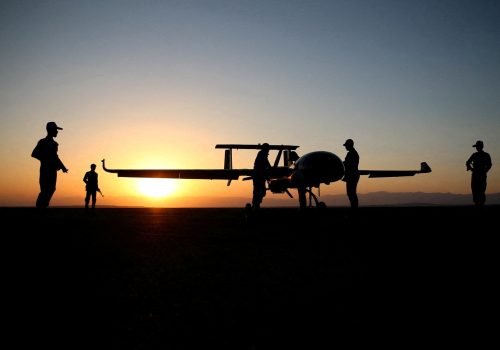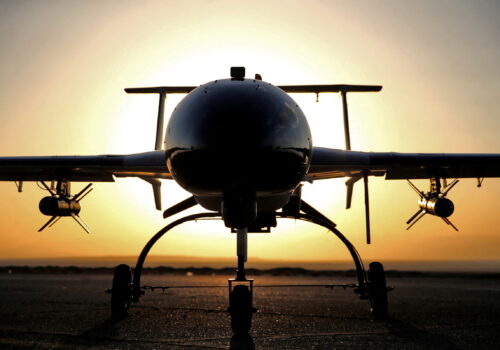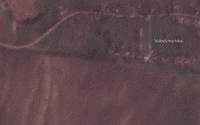Iranian drones have proliferated under US watch
According to senior military officials and independent analysis by the Global Terrorism Trends and Analysis Center (GTTAC), which provides data to the State Department’s Counterterrorism Bureau, most attack unmanned aerial vehicles (UAVs) used in the world today originate from Iran. Notably, the GTTAC data do not include Iranian drones used by Russia as part of its full-scale invasion of Ukraine.
Iran’s record-setting proliferation of attack UAVs did not happen overnight. Although the solution to stop the spread of Iranian drones is complex, it is important to note that there were plenty of warnings and time for the United States to prepare its defenses. In 2021, Secretary of Defense Lloyd Austin delivered remarks at the annual Manama Dialogue to reassure the region of US security commitments, as the dialogue occurred only three months after the chaotic US withdrawal from Afghanistan. The remarks also occurred after the United States began its Global Posture Review and the Department of Defense (DOD) had already withdrawn a significant portion of its defense capability from the region. Austin had good reason to assuage regional leaders’ doubts about US credibility and commitment to the region. Notably, the remarks underscored another area in which the United States must reconsider its approach.
SIGN UP FOR THIS WEEK IN THE MIDEAST NEWSLETTER
By the time of the Manama Dialogue speech, Iran had proven its ability to regularly transfer sufficient quantities of drone components to the Houthi rebels in Yemen, resulting in the launch of hundreds of UAV and missile attacks against Saudi Arabia. Iran’s proliferation of UAVs to its regional proxies began in earnest several years earlier. In 2019, the Defense Intelligence Agency’s Iran Military Power Study noted that Iran was pursuing more and increasingly capable UAVs. The study also indicated that Iran was proliferating these systems to the Houthis in Yemen and Shia militia groups in Iraq and Syria. In his Manama remarks, Austin congratulated the Saudis for defeating nearly 90 percent of UAVs and missiles fired from Yemen, and promised to work with the Saudis to provide 100 percent coverage against attack.
Russia’s full-scale invasion of Ukraine in February 2022 provided a new opening for Iran—this time to supply Russia with lethal drones. With the UAV transfers first reported in mid-2022 and with more than one thousand UAVs reportedly delivered, Iran’s assistance to Russia appears to have ushered in a new period of strategic partnership between the two countries. Although the Iran-Russia partnership creates long-term security complications, the more immediate effects of Iranian drones were to come from Yemen. Following the October 7, 2023 Hamas attack and Israel’s subsequent military campaign in Gaza, Houthi attacks on Red Sea shipping and subsequent diversion of maritime traffic necessitated the establishment of Operation Prosperity Guardian and multiple rounds of US and allied strikes, as well as the predictable Houthi response attacks. Prior to the Houthis’ partial closure of Red Sea Shipping, the US government took several proactive steps.
It is just as important to disrupt the supply chain to limit UAV proliferation and attacks as it is to mount an adequate defense. In the case of Iran, the US government has identified and sanctioned the various suppliers of Iran’s UAV production enterprise. This effort included US Treasury designations of front companies in China, Russia, Turkey, and Germany. Because sanctions alone are ineffective, there has also been an international effort to interdict Iranian supply routes. Even before the advent of Operation Prosperity Guardian, the United States and allied nations, like the United Kingdom and France, conducted regular interdictions and seizures of Iranian smuggled material. However, these designations and interdictions were not enough. Even after the October 7, 2023 attacks caused the United States to reestablish a more robust naval presence in the Middle East, comprehensive interdiction of Iranian smuggled lethal assistance proved elusive. As much as stopping maritime smuggling remains a challenge, interdicting overland smuggling from Iran to militia groups in Iraq and Syria reportedly represents an even greater challenge.
Another potential option would be to destroy Iran’s production facilities. However, US administrations have avoided attacking drone production facilities inside Iran due to the risk of regional escalation. The most practical option has been to upgrade US defenses against UAVs. Since both the 2019 DIA Iran Power Study and Secretary Austin’s 2021 Manama Dialogue remarks indicated an appreciation for Iran’s UAV and missile-proliferation capability, this effort should already be well underway. However, the DOD’s institutional and executive-level recognition of the Iranian threat has yet to fully translate into a reallocation of resources in the DOD’s Planning, Programming, Budgeting, and Execution (PPBE) process.
While the armed services have authority over major acquisitions, none of the services have wanted to devote a significant portion of their budget away from higher-priority Indo-Pacific and Eurasia based threats articulated in the National Defense Strategy. The Pentagon created a Joint Counter Unmanned Aerial System Office, but without the authority to direct major, service-level acquisitions, it focused on testing, training, and doctrine. In the $849.8-billion 2025 fiscal year budget request, the US Army has a $299.8 million line-item request for counter-UAV systems. In the US Central Command (CENTCOM) region, where there has been a clear threat for years, CENTCOM requested $17.1 billion in the budget. The 2025 fiscal year budget amount was $3.8 billion less than that for 2024. Although these CENTCOM funds go toward operational expenses, a fraction of the funds would go toward acquiring counter-UAV systems like the Coyote launcher system. Because CENTCOM also does not have authority over major program acquisitions, the systems it is acquiring do not have the validation of a service-level acquisition and haven’t been integrated across the military.
With recent annual defense budgets ranging from $700 billion to more than $800 billion, it is not clear why the Pentagon did not devote more resources to low-cost, plentiful defenses against an ever-growing threat. In addition to his description of how Iran uses its missiles and UAVs, a testimony by General Michael Kurilla clarified that US and coalition forces have experienced 175 Iran-supported attacks in Iraq, Syria, and Jordan since October 7, 2023. These attacks only span five months and do not include a number of previous attacks, including one that killed a US contractor in 2023. Additionally, senior Pentagon officials recently indicated that US Navy forces in the Red Sea have defended against almost one hundred Houthi attacks, with almost every attack involving a variety of Iranian-supplied drones and missiles. Based on the cost of the defensive missiles fired from a US Navy warship, destroying these Houthi attacks has already led to $1 billion of unbudgeted expenses. Iranian proxies are proving their ability to deplete the US military’s stores of its long-range and expensive air defense missiles.
However, unplanned expenses are not the worst part about mounting an adequate defense against drones and missiles, whether they originate from Iran or some other malign actor. One of the attacks mentioned in the CENTCOM posture testimony was an attack that led to the deaths of three US service members. Although death is not entirely preventable in conflict, the threat trend from Iran had been clear. The Pentagon could have done more to prepare for Iranian UAV proliferation and the range of opportunistic attacks that Kurilla described. At the same time that Secretary Austin had congratulated the Saudis for defending against Iranian-supplied Houthi attacks, the Pentagon should have undertaken a comprehensive effort, similar to the 2022 Foreign Military Sales Tiger Team, to improve US defenses against the mounting numbers of low-cost, widely proliferated UAVs and missiles from Iran. Whether doing so would have saved lives is unknown, but the effort and funds expended would not have been wasted.
Daniel E. Mouton is a nonresident senior fellow at the Scowcroft Middle East Security Initiative of the Atlantic Council’s Middle East Programs.
Further reading
Wed, Nov 23, 2022
Drone sales to Russia spark a debate in Iran
IranSource By Javad Heiran-Nia
The revelation that Iran has sold drones to Russia that the latter is now using to attack Ukraine has touched off a debate about whether this growing closeness to Russia is in Iran’s national interest.
Thu, Nov 18, 2021
Iran’s drones are clones. Now they’re being used in multiple conflicts.
IranSource By Seth J. Frantzman
Iran’s military drone program has grown in recent years and Iran-backed groups have increasingly used drones in conflicts.
Fri, Feb 2, 2024
Iran is on its way to replacing Russia as a leading arms exporter. The US needs a strategy to counter this trend.
IranSource By Danny Citrinowicz
The US must understand the seriousness of the situation: without active measures, it will be extremely tough to stop Iran from becoming a world leader in arms sales
Image: A veiled Iranian schoolgirl, stands next to an Israeli flag, observe the American Global Hawk (R) drone, which was shot down by the Islamic Revolutionary Guard Corps (IRGC) in the Strait of Hormuz in June 2019, as well as an American Reaper MQ-1 drone, as she visits of Iran’s Islamic Revolutionary Guard Corps (IRGC) National Aerospace Park in western Tehran, October 11, 2023. The IRGC National Aerospace Park, showcasing the achievements of the IRGC Aerospace Force, was inaugurated on September 27, 2020, by IRGC Commander-in-Chief Major General Hossein Salami and IRGC Aerospace Force Brigadier General Amir Ali Hajizadeh. In February, the IRGC Aerospace Force commander announced Iran’s expertise in guiding solid-propellant missiles beyond the Earth’s atmosphere. (Photo by Morteza Nikoubazl/NurPhoto)



